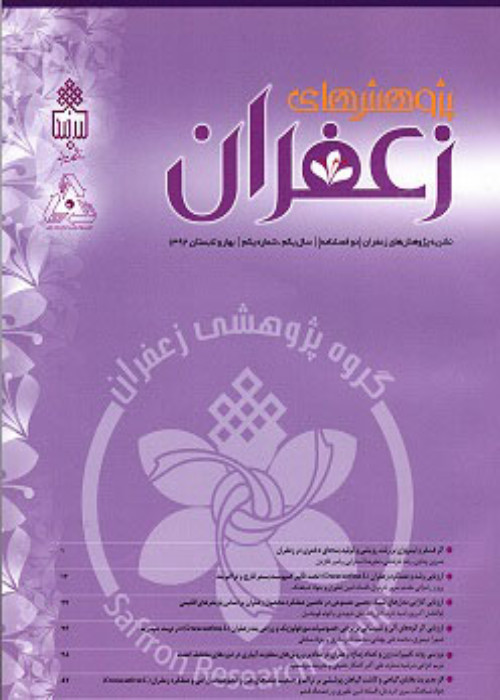Studying the Effect of Seaweed, Lignin and Tea Compost on the Amount of Crocin, Picrocrocin, Safranal and Some Phytochemical Traits in Petals and Stigmas of Saffron Plant (Crocus Sativus L.)
Introduction
The Crocus genus from the Iridaceae family has more than 70 ornamental species that are very valuable because of the beautiful color of the flower and are used in gardening and green spaces. Among the industrial and export products of Iran, saffron has found a special place as the most valuable agricultural and medical product in the world. The most important compounds in saffron are crocin, picrocrocin, and safranal, which are responsible for color, smell, and taste, respectively. The new approach to producing medicinal plants goes towards increasing the quantity and quality of the effective substance by using sustainable and organic farming methods, so using organic fertilizers in growing medicinal plants becomes necessary to achieve these goals.
This research was conducted based on a randomized complete block design with four replications in a saffron farm in Kashmar city and Gorgan University of Agricultural Sciences and Natural Resources Laboratory. Treatments include Kelp seaweed extract in four concentrations (0, 1, 2, 3 mg.l-1), tea compost (0, 200, 300, 400 mg.l-1) and lignin (0, 500, 1000, 1500 mg.l-1). The treatments were carried out at the end of September along with the first irrigation. The research farm was in the sixth year of saffron cultivation. The planting distance was 20×30 cm and 15 corms were planted per square meter. The weight of the corms was 8-10 grams. Sampling from each experimental unit was done randomly. 10 plants were randomly selected from the middle of each plot. The flower was harvested during two weeks and at the beginning of the day, and then the petals were separated from the stigma. After harvesting the flowers and stigmas, they were transferred to a room with a temperature of 21-25 degrees Celsius and relative humidity of 41-52% for drying, using the dry shade method. The measured variables included total phenol, total flavonoids, antioxidant activity, anthocyanin in stigma and petal tissues, and total safranal, total crocin, and total picrocrocin in stigma tissue.
The results showed that the treatments were significant at one percent. The mean comparison showed that the highest amount of stigma total phenol (6.75 mg.g-1) was observed in 3 mg.l-1 of seaweed treatment, and the highest amount of stigma total flavonoids (2.04 mg.g-1) was seen in the interaction of 500 mg.l-1 of lignin, 1 mg.l-1 seaweed, and 200 mg.l-1 tea compost. The highest amount of petal anthocyanin (0.42 mg.g-1) was recorded in 2 mg.l-1 seaweed treatment, the highest percentage of stigma antioxidant capacity (10.47%), and the highest amount of stigma anthocyanin (0.047 mg.g-1) was observed in the control treatment. Based on the results of the mean comparison, no difference was observed between most of the treatments, but the treatment of 1500 mg per liter of lignin (47.24%) increased lignin with a small difference. The lowest amount (24.16%) was related to the 500 mg. l-1 lignin treatment. According to the amount of crocin in the control, it can be concluded that the treatment did not have a great effect on the amount of total crocin in saffron.
Finally, it can be concluded that seaweed fertilizers, lignin, and tea compost had a good effect on the saffron plant, and considering the economic importance of this plant, using biological and organic fertilizers as much as possible and replacing them with chemical fertilizers has a positive effect in agriculture. So that, this research had the highest number of flowers and the highest stigma weight in compost tea treatment, which is one of the important factors desired by most farmers. In some treatments, a high level of phenol and anthocyanin in the petals compared to the stigma was seen, which makes pay more attention to the metabolites of the petals, and in some cases, even more advantages than the saffron stigma.
- حق عضویت دریافتی صرف حمایت از نشریات عضو و نگهداری، تکمیل و توسعه مگیران میشود.
- پرداخت حق اشتراک و دانلود مقالات اجازه بازنشر آن در سایر رسانههای چاپی و دیجیتال را به کاربر نمیدهد.


